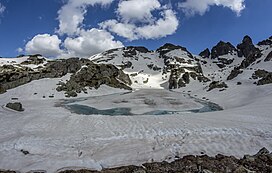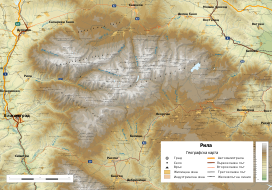
Back Rila ALS جبال ريلا Arabic Montes Rila AST Рыла (горны масіў) Byelorussian Рыла BE-X-OLD Рила Bulgarian Rila Catalan Rila (kabukiran) CEB Rila Czech Рила CU
| Rila Mountains | |
|---|---|
| Bulgarian: Рила | |
 Strashnoto ezero (The Dreadful Lake) | |
| Highest point | |
| Peak | Musala |
| Elevation | 2,925 m (9,596 ft) |
| Coordinates | 42°06′00″N 23°33′00″E / 42.10000°N 23.55000°E |
| Dimensions | |
| Length | 75 km (47 mi) west-east |
| Width | 50 km (31 mi) north-south |
| Area | 2,629 km2 (1,015 sq mi) |
| Geography | |
| Country | Bulgaria |
| Geology | |
| Type of rock | granite, gneiss, quartz |
Rila (Bulgarian: Рила, pronounced [ˈriɫɐ]) is the highest mountain range of Bulgaria, the Balkan Peninsula, and Southeast Europe. It is situated in southwestern Bulgaria and forms part of the Rila–Rhodope Massif. The highest summit is Musala at an elevation of 2,925 m which makes Rila the sixth highest mountain range in Europe after the Caucasus, the Alps, Sierra Nevada, the Pyrenees and Mount Etna, and the highest one between the Alps and the Caucasus. It spans a territory of 2,629 km2 with an average elevation of 1487 m. The mountain is believed to have been named after the river of the same name, which comes from the Old Bulgarian verb "рыти" meaning "to grub".[1][2]
Rila has abundant water resources. Some of the Balkans' longest and deepest rivers originate from Rila, including the Maritsa, Iskar and Mesta rivers. Bulgaria's main water divide separating the Black Sea and the Aegean Sea drainage systems follows the main ridge of Rila. The mountain range is dotted with almost 200 glacial lakes such as the renowned Seven Rila Lakes, and is rich in hot springs in the fault areas at the foothills, including the hottest spring in South-eastern Europe in Sapareva Banya.
The mountain range has varied flora and fauna with a number of endemic and relict species and some of the best preserved forests in the country. The biodiversity and the pristine landscapes are protected by Rila National Park which covers much of the mountain; the rest lies within Rila Monastery Nature Park. In addition, there are five nature reserves: Parangalitsa, Central Rila Reserve, Rila Monastery Forest, Ibar and Skakavitsa.
The most recognisable landmark of the mountain range is the Rila Monastery, Bulgaria's largest and most important monastery, founded in the 10th century by Saint John of Rila. Due to its outstanding cultural and spiritual value it was declared a UNESCO World Heritage Site in 1983. Rila is also a popular destination for hiking, winter sports and spa tourism, hosting the nation's oldest ski resort Borovets, as well as numerous hiking trails. Some of the most important hydro power stations in Bulgaria are situated in the eastern part of the mountain range.
- ^ Български етимологичен речник, том 6, Академично издателство "Професор Марин Дринов", София 2002, стр. 256-257
- ^ Иван Дуриданов, Южнославянските речни названия и тяхното значение за славянския топонимичен атлас, Славянска филология 3, Българска академия на науките, София 1963, стр.197 Eprints.nbu.bg
© MMXXIII Rich X Search. We shall prevail. All rights reserved. Rich X Search
